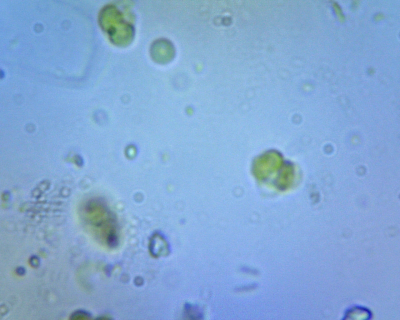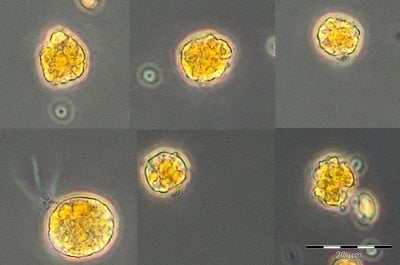Let me check it out thanks a lot!@Jolanta here.....lemme know if it's close, or just coincidence that I thought so.
Navigation
Install the app
How to install the app on iOS
Follow along with the video below to see how to install our site as a web app on your home screen.
Note: This feature may not be available in some browsers.
More options
You are using an out of date browser. It may not display this or other websites correctly.
You should upgrade or use an alternative browser.
You should upgrade or use an alternative browser.
Dinoflagellates – Are You Tired Of Battling Altogether?
- Thread starter mcarroll
- Start date
- Tagged users None
They look very similar to the pictures from that tread https://www.reef2reef.com/index.php?threads/299585/ so I think they are chrysophytes 
I think they are chrysophytes
Check out that thread as well as @reeferfoxx's chrysophyte thread!
"Knowing is half the battle..."
- Joined
- Sep 8, 2015
- Messages
- 6,514
- Reaction score
- 6,512
I did. I don't thinks chrysos
I did. I don't thinks chrysos
Seemed similar to the other photos to me, but I know I'm no ID expert.
Any other guesses at an ID?
- Joined
- Sep 8, 2015
- Messages
- 6,514
- Reaction score
- 6,512
In darkskys images the first two "larger" green blobs I believe are phytoplankton. The smaller more rigid cells are chrysos. It's consistent with my chrysos.(no filter)Seemed similar to the other photos to me, but I know I'm no ID expert.
Any other guesses at an ID?

The color is off and the consistency is difficult to say. The overall growth is patchy which would suggest chrysos to an extent but looks more like lyngbya without the long filaments.
Though, and I have to correct my earlier assessment of chrysos being silicate based like diatoms, in fact traps other protists like diatoms and feeds off the nutrients. So, I suppose the the ID would be dependent on A) not being able to identify a benthic unicellular cyanobacteria and B) giving more details as to what the suspected chrysos are trapping. I say this because chrysos contain chlorophyll a and c. This pigment should be more green in coloration. But i'll accept an incorrect ID given limited information.
- Joined
- Sep 8, 2015
- Messages
- 6,514
- Reaction score
- 6,512
I made so video today, I can see a lot of worms I really dont know the kind, and once again only those small gold things
Im uploading one more with max 900 magnification.
Im uploading one more with max 900 magnification.
If it clumps together and blows off of your rocks easily enough, its probably chrysophytes. They're a photosynthetic algae that thrive in sterile low nutrient conditions, in the wild they're found in ponds with little to no nitrates or phosphates.
The university now has a healthy culture it my strain in an aquarium that has two large BRS reactors of GFO running to keep them happy.
Knowing this, I'd recommend taking your GFO offline for awhile, you're just compounding the problem. Let your phosphates and nitrates increase if not dose more yourself to increase the levels.
It is a photosynthetic algae, so really consider doing a lights out period or two. I did three sets to kick mine completely. After one three day period you will notice that most of it is gone or dead. If you have chaeto, keep the refugium light going unless you notice cheysochryso in there as well.
Good luck!
The university now has a healthy culture it my strain in an aquarium that has two large BRS reactors of GFO running to keep them happy.
Knowing this, I'd recommend taking your GFO offline for awhile, you're just compounding the problem. Let your phosphates and nitrates increase if not dose more yourself to increase the levels.
It is a photosynthetic algae, so really consider doing a lights out period or two. I did three sets to kick mine completely. After one three day period you will notice that most of it is gone or dead. If you have chaeto, keep the refugium light going unless you notice cheysochryso in there as well.
Good luck!
Yesterday I saw it more long and not so thick and my turbo snail are eating it, I saw the same think in my big tank, first it was clear and short, then got darker and longer and my tangs started eating it and then it disapeared. Maybe it gets darker when its dying? When I had ostreospis I never saw so many worms in the scope like I do now, maybe couse ostreopsis disapired the worms are reproducing now. I would like to know what kind of worms they are.
- Joined
- Sep 8, 2015
- Messages
- 6,514
- Reaction score
- 6,512
Nutrients werent the deciding factor for my chrysos. Actually at one point I think I found high phosphates were the cause. At the start I had 0.21 ppm po4 and overall or 6 months down the road, nutrients were stable at po4 0.02 and no3 2ppm. The last success story against chrysos,, the reefer reduced all nutrients to beat it. Also, do you think freshwater chysos are the same as benthic or marine chrysos?They're a photosynthetic algae that thrive in sterile low nutrient conditions, in the wild they're found in ponds with little to no nitrates or phosphates.
If mine really are chrysos its posible the cause is high phosphate, mine was 0.2 and now its down to 0.05, my nitrates always was really low about 0.2.Nutrients werent the deciding factor for my chrysos. Actually at one point I think I found high phosphates were the cause. At the start I had 0.21 ppm po4 and overall or 6 months down the road, nutrients were stable at po4 0.02 and no3 2ppm. The last success story against chrysos,, the reefer reduced all nutrients to beat it. Also, do you think freshwater chysos are the same as benthic or marine chrysos?
The last success story against chrysos,, the reefer reduced all nutrients to beat it. Also, do you think freshwater chysos are the same as benthic or marine chrysos?
If mine really are chrysos its posible the cause is high phosphate, mine was 0.2 and now its down to 0.05, my nitrates always was really low about 0.2.
I don't know for sure, but my suspicion is that they may simply be responding to a disturbance moreso than the specific conditions present. This is often the case for other algae, so maybe a factor here too.
Back when I was researching this a few years back I was never able to find enough info on chrysophytes to gain much broad knowledge about them. Will have to take another look today on the GoogScholar...
- Joined
- Sep 8, 2015
- Messages
- 6,514
- Reaction score
- 6,512
I dont see it?Ok, here:
Mass development of marine benthic Sarcinochrysidales (Chrysophyceae sl) in Corsica
Looks JUST like our stuff.
- Joined
- Sep 8, 2015
- Messages
- 6,514
- Reaction score
- 6,512
(mine at least)
Ok i see it now! (With another site
https://www.researchgate.net/public...arcinochrysidales_Chrysophyceae_sl_in_Corsica
- Joined
- Sep 8, 2015
- Messages
- 6,514
- Reaction score
- 6,512
This would verify my assessment, no?
The development of the Phaeocystis blooms in
the North Sea (Lancelot 1995) is apparently due to
the increase of N relative to P and especially silica.
Mucilage development in the Adriatic Sea also seems
to depend largely on the N/P ratio, the physical envi-
ronment and climatic conditions (Rinaldi et al. 1995).
Mass Development of Marine Benthic Sarcinochrysidales (Chrysophyceae s.l. ) in Corsica (PDF Download Available). Available from: https://www.researchgate.net/public...arcinochrysidales_Chrysophyceae_sl_in_Corsica [accessed Feb 20 2018].
The development of the Phaeocystis blooms in
the North Sea (Lancelot 1995) is apparently due to
the increase of N relative to P and especially silica.
Mucilage development in the Adriatic Sea also seems
to depend largely on the N/P ratio, the physical envi-
ronment and climatic conditions (Rinaldi et al. 1995).
Mass Development of Marine Benthic Sarcinochrysidales (Chrysophyceae s.l. ) in Corsica (PDF Download Available). Available from: https://www.researchgate.net/public...arcinochrysidales_Chrysophyceae_sl_in_Corsica [accessed Feb 20 2018].
Similar threads
- Replies
- 43
- Views
- 544
- Replies
- 1
- Views
- 90
- Replies
- 4
- Views
- 252






















